inflation pressure TOYOTA CAMRY HV 2009 Owners Manual
[x] Cancel search | Manufacturer: TOYOTA, Model Year: 2009, Model line: CAMRY HV, Model: TOYOTA CAMRY HV 2009Pages: 444, PDF Size: 6.46 MB
Page 4 of 444

TABLE OF CONTENTSIndex
4
Trunk features .................... 263
Garage door opener ........... 264
Compass ............................ 269
4-1. Maintenance and care...... 274 Cleaning and protecting the vehicle exterior ........... 274
Cleaning and protecting the vehicle interior ............ 276
4-2. Maintenance ..................... 279 Maintenance requirements .................... 279
General maintenance ......... 281
Emission inspection and maintenance (I/M)
programs .......................... 284
4-3. Do-it-yourself maintenance ................... 285
Do-it-yourself service precautions ...................... 285
Hood................................... 288
Positioning a floor jack ....... 289
Engine compartment .......... 291
12-volt battery .................... 300
Tires ................................... 304
Tire inflation pressure......... 313
Wheels ............................... 317
Air conditioning filter ........... 319
Key battery ......................... 322
Checking and replacing fuses ................................ 325
Light bulbs .......................... 336 5-1. Essential information ....... 342
If your vehicle needs to be towed ........................... 342
If you think something is wrong ................................ 345
Event data recorder ............ 346
5-2. Steps to take in an emergency ...................... 348
If a warning light turns on or a warning buzzer
sounds... .......................... 348
If a warning message is displayed .......................... 357
If you have a flat tire ........... 368
If the hybrid system will not start ............................ 378
If the shift lever cannot be shifted from P ................... 380
If you lose your keys ........... 381
If the electronic key does not operate properly ......... 382
If the vehicle’s 12-volt battery is discharged ........ 385
If your vehicle overheats..... 389
If the vehicle becomes stuck ................................. 393
4Maintenance and care
5When trouble arises
Page 7 of 444
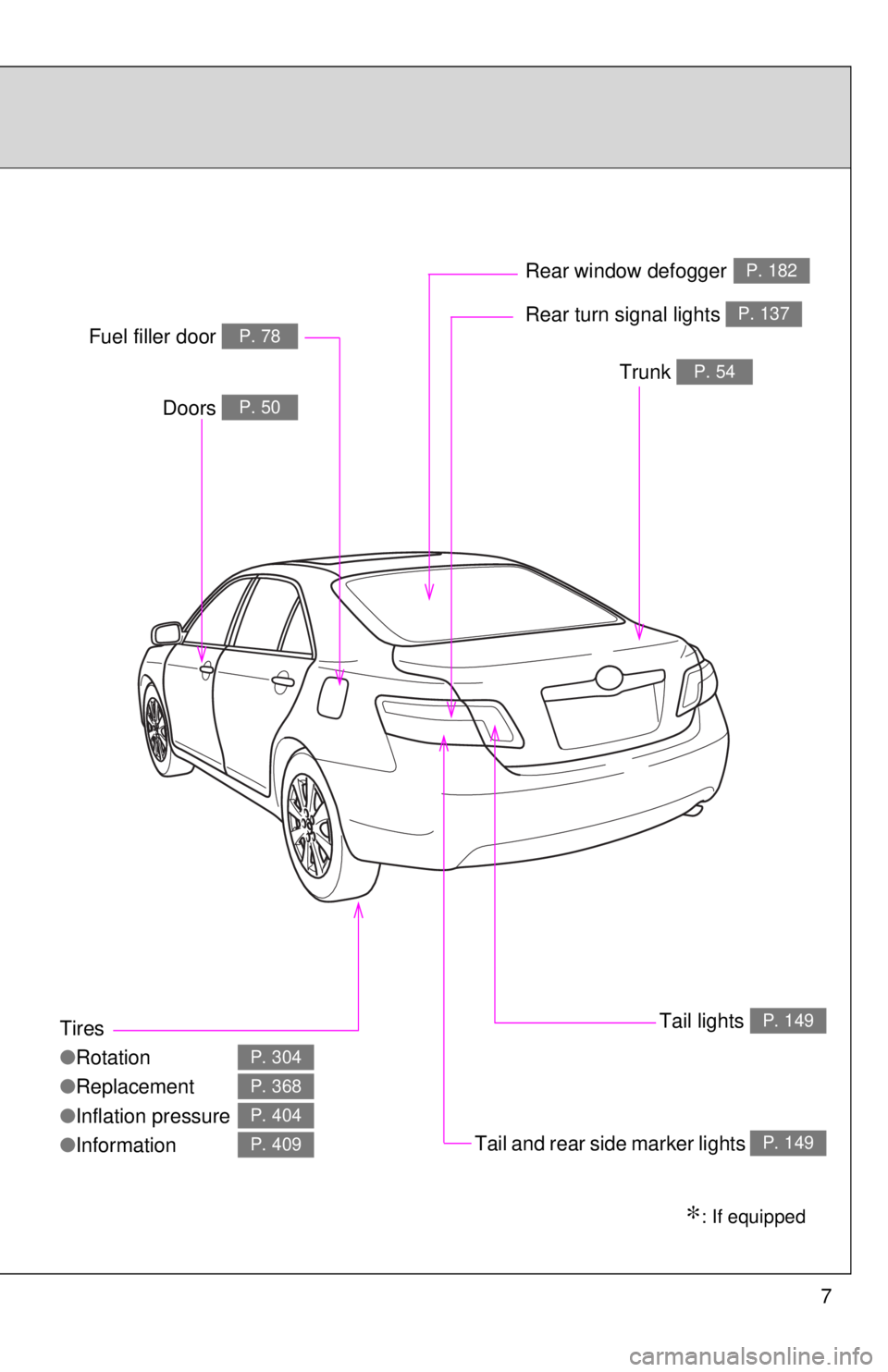
7
Tires
●Rotation
● Replacement
● Inflation pressure
● Information
P. 304
P. 368
P. 404
P. 409
Trunk P. 54
Doors P. 50
Fuel filler door P. 78Rear turn signal lights P. 137
Rear window defogger P. 182
Tail lights P. 149
∗: If equipped
Tail and rear side marker lights P. 149
Page 273 of 444
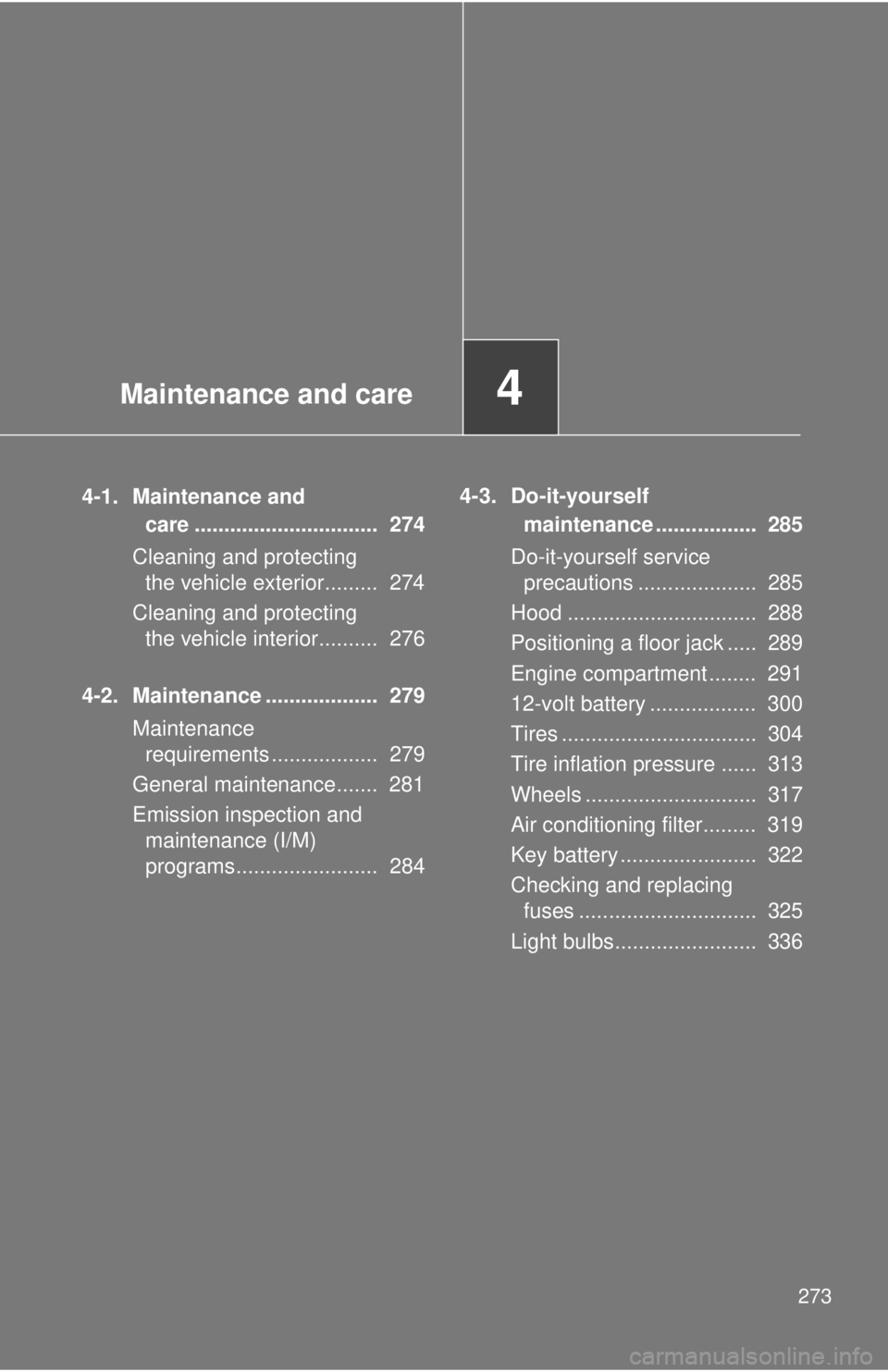
Maintenance and care4
273
4-1. Maintenance and care ............................... 274
Cleaning and protecting the vehicle exterior......... 274
Cleaning and protecting the vehicle interior.......... 276
4-2. Maintenance ................... 279 Maintenance requirements .................. 279
General maintenance....... 281
Emission inspection and maintenance (I/M)
programs........................ 284 4-3. Do-it-yourself
maintenance ................. 285
Do-it-yourself service precautions .................... 285
Hood ................................ 288
Positioning a floor jack ..... 289
Engine compartment ........ 291
12-volt battery .................. 300
Tires ................................. 304
Tire inflation pressure ...... 313
Wheels ............................. 317
Air conditioning filter......... 319
Key battery ....................... 322
Checking and replacing fuses .............................. 325
Light bulbs........................ 336
Page 283 of 444
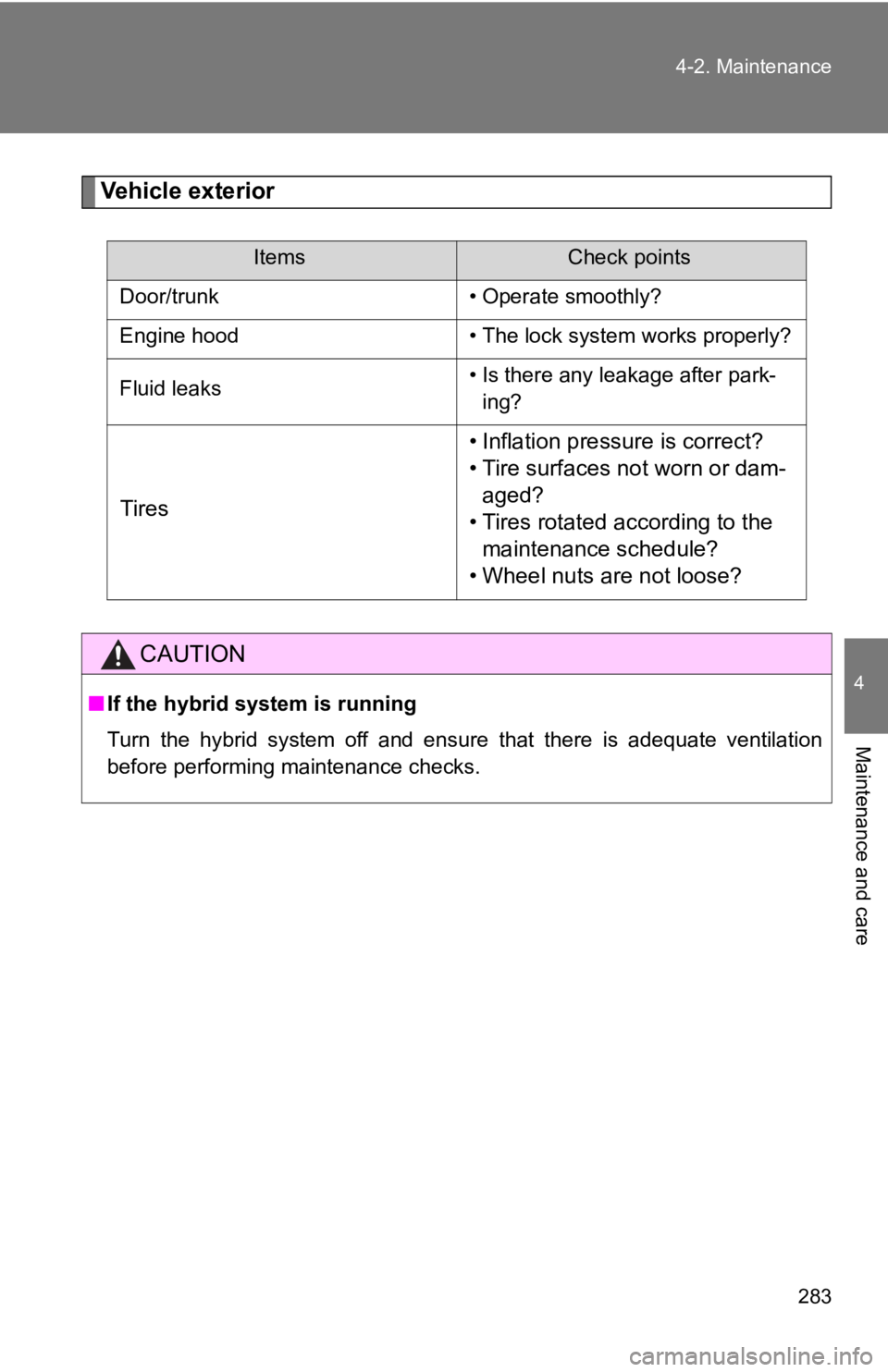
283
4-2. Maintenance
4
Maintenance and care
Vehicle exterior
ItemsCheck points
Door/trunk • Operate smoothly?
Engine hood • The lock system works properly?
Fluid leaks • Is there any leakage after park-
ing?
Tires • Inflation pressure is correct?
• Tire surfaces not worn or dam-
aged?
• Tires rotated according to the maintenance schedule?
• Wheel nuts are not loose?
CAUTION
■ If the hybrid system is running
Turn the hybrid system off and ensure that there is adequate ventilation
before performing maintenance checks.
Page 286 of 444
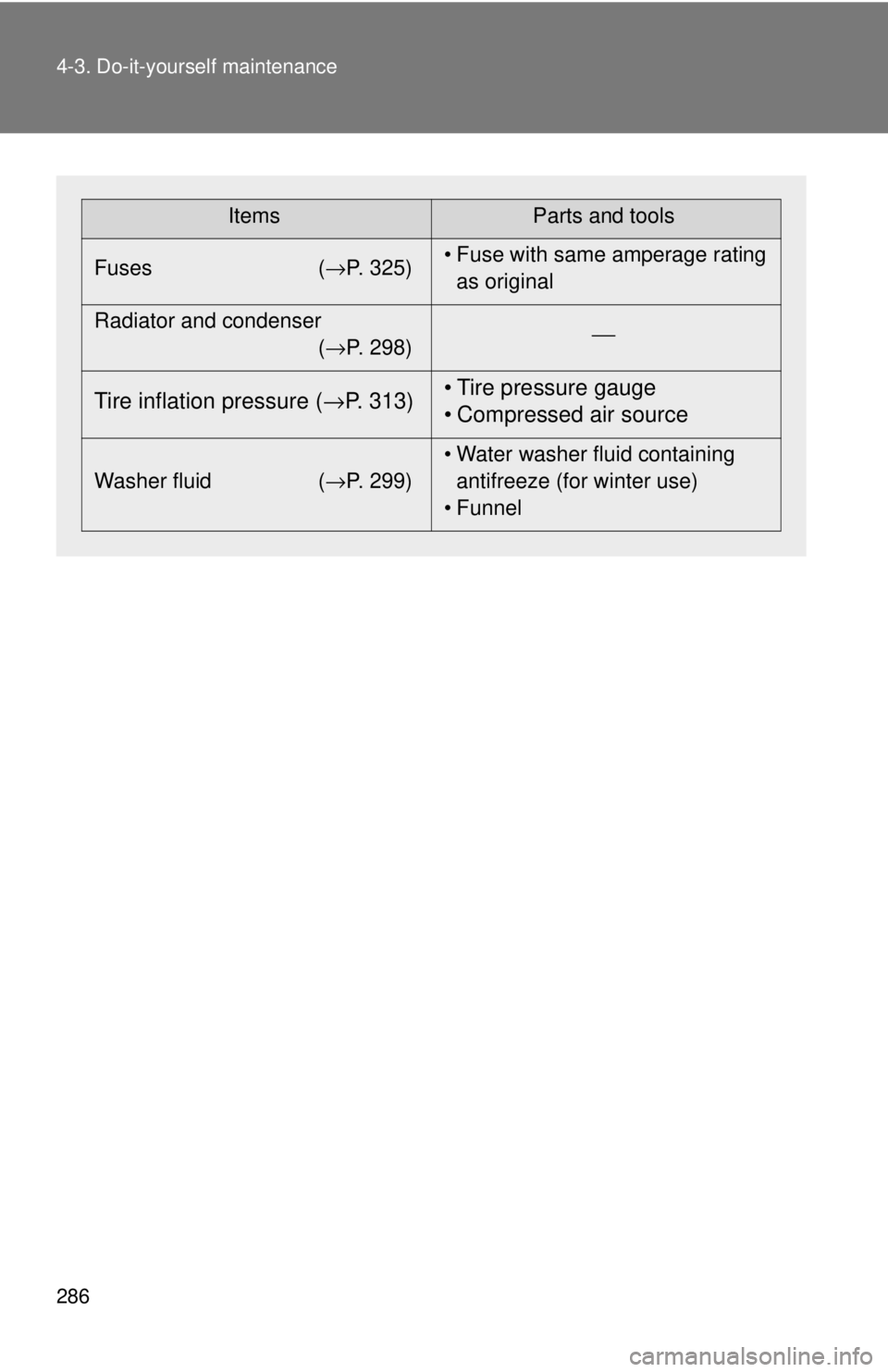
286 4-3. Do-it-yourself maintenance
ItemsParts and tools
Fuses ( →P. 325)• Fuse with same amperage rating
as original
Radiator and condenser (→P. 298) ⎯
Tire inflation pressure (
→P. 313) • Tire pressure gauge
• Compressed air source
Washer fluid
(→P. 299) • Water washer fluid containing
antifreeze (for winter use)
• Funnel
Page 304 of 444
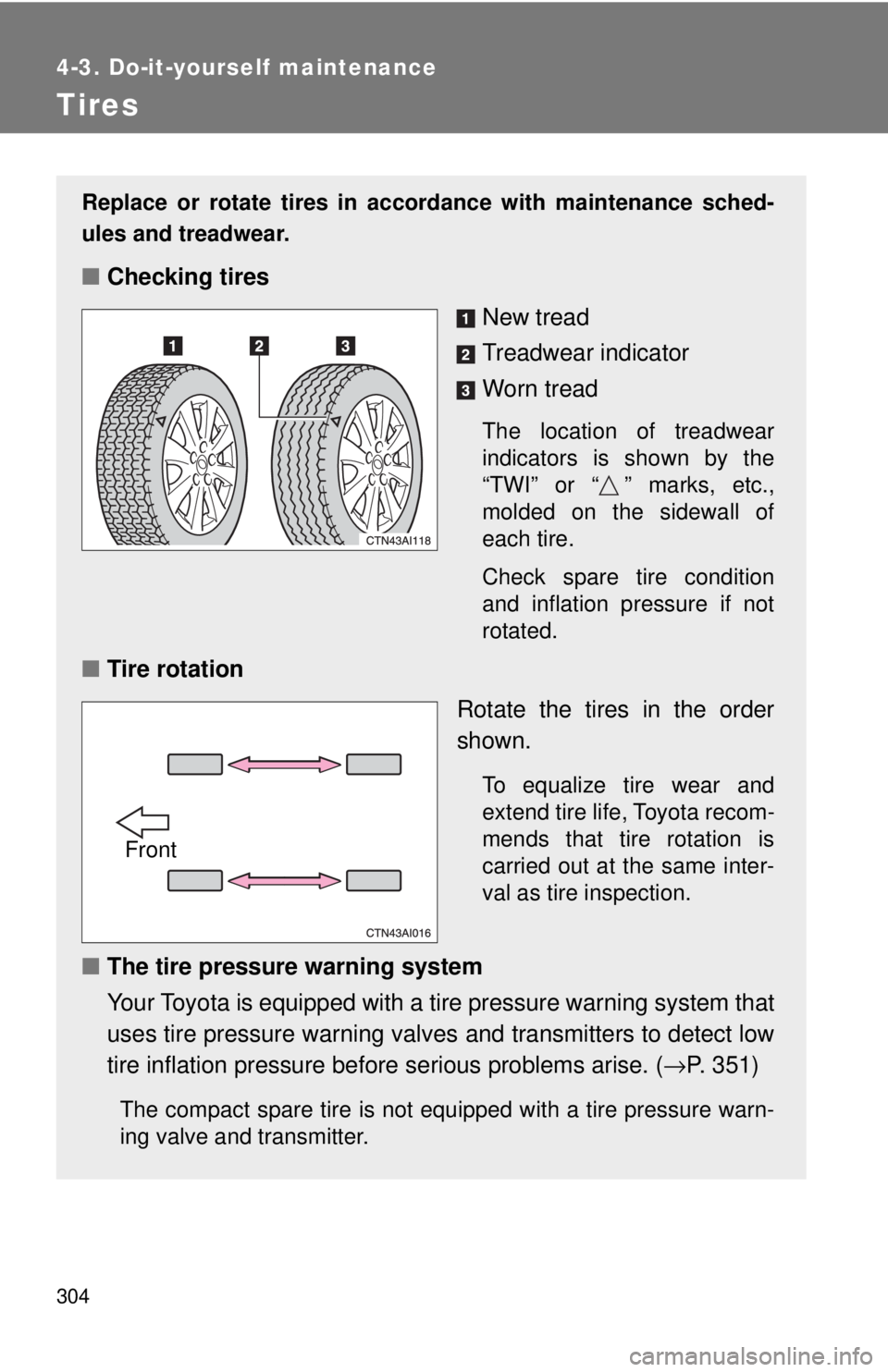
304
4-3. Do-it-yourself maintenance
Tires
Replace or rotate tires in accordance with maintenance sched-
ules and treadwear.
■Checking tires
New tread
Treadwear indicator
Worn tread
The location of treadwear
indicators is shown by the
“TWI” or “ ” marks, etc.,
molded on the sidewall of
each tire.
Check spare tire condition
and inflation pressure if not
rotated.
■Tire rotation
Rotate the tires in the order
shown.
To equalize tire wear and
extend tire life, Toyota recom-
mends that tire rotation is
carried out at the same inter-
val as tire inspection.
■The tire pressure warning system
Your Toyota is equipped with a ti re pressure warning system that
uses tire pressure warning valves and transmitters to detect low
tire inflation pressure before serious problems arise. (→P. 351)
The compact spare tire is not equipped with a tire pressure warn-
ing valve and transmitter.
Front
Page 305 of 444

305
4-3. Do-it-yourself maintenance
4
Maintenance and care
Installing tire pressure warning valves and transmitters
When replacing tires or wheels, tire pressure warning valves and
transmitters must also be installed.
When new tire pressure warning valves and transmitters are
installed, new tire pressure warning valve and transmitter ID codes
must be registered in the tire pr essure warning computer and tire
pressure warning system must be initialized. Have tire pressure
warning valve and transmitter ID codes registered by your Toyota
dealer. ( →P. 306)
Initializing the tire pressure warning system
■ The tire pressure warning system must be initialized when the
tire inflation pressure is changed (such as when changing
traveling speed).
When the tire pressure warning syst em is initialized, the current tire
pressure is set as the pressure benchmark.
■ How to initialize the tire pressure warning system
Park the vehicle in a safe place and turn off the hybrid system.
Initialization is not performed while the vehicle is moving.
Adjust the tire pressure to the specified pressure. (→P. 4 0 4 )
Make sure to adjust the tire pressure to the specified cold tire
inflation pressure level. The tire pressure warning system will
operate based on this pressure level.
Turn the “POWER” switch to ON mode.
STEP1
STEP2
STEP3
Page 307 of 444

307
4-3. Do-it-yourself maintenance
4
Maintenance and care
■When to replace your vehicle’s tires
Tires should be replaced if:
●You have tire damage such as cuts, splits, cracks deep enough to
expose the fabric or bulges indicating internal damage
●A tire goes flat repeatedly or cann
ot be properly repaired due to the
size or location of a cut or other damage
If you are not sure, consult with your Toyota dealer.
■Replacing tires and wheels
If the ID code of the tire pressure warning valve and transmitter is not
registered, the tire pressure warni ng system will not work properly. After
about 20 minutes, the tire pressure warning light comes on after blinking
for 1 minute to indicate a system malfunction.
■Tire life
Any tire over 6 years old must be checked by a qualified technician even
if they have seldom or never been used or damage is not obvious.
■If the tread wears down below 0.16 in. (4 mm) on snow tires
The effectiveness of snow tires is lost.
■If you press the tire pressure warning reset switch accidentally
If initialization is performed, adjust the tire inflation pressure to the specified
level and initialize the tire pressure warning system again.
Page 308 of 444

308 4-3. Do-it-yourself maintenance
■When the initialization of the tire pressure warning system has failed
Initialization can be completed in a few minutes. However, in the following
cases, the settings has not been recorded and the system will not operate
properly. If repeated attempts to record tire inflation pressure settings are
unsuccessful, have the vehicle inspected by your Toyota dealer.
● When operating the tire pressure warning reset switch, the tire pressure
warning light does not flash 3 times.
● After driving for a certain period of time since the initialization has been
completed, the tire pressure warning light comes on after blinking for 1
minute.
■
Routine tire inflation pressure checks
The tire pressure warning system doe s not replace routine tire inflation
pressure checks. Make sure to check tire inflation pressure as part of
your routine of daily vehicle checks.
■Maximum load of tire
Check that the maximum load of the re placed tire is greater than 1/2 of
the Gross Axle Weight Ratings (GAWR) of either the front axle or the
rear axle, whichever is greater.
For the maximum load of the tire, see the load limit at maximum cold tire
inflation pressure mentioned on the sidewall of the tire, and for the Gross
Axle Weight Ratings (GAWR), s ee the Certification Label. (→P. 313,
409).
Page 309 of 444

309
4-3. Do-it-yourself maintenance
4
Maintenance and care
■Tire types
1 Summer tires
Summer tires are high-speed performance tires best suited to highway
driving under dry conditions. Since summer tires do not have the same
traction performance as snow tire s, summer tires are inadequate for
driving on snow-covered or icy roads. For driving on snow-covered
roads or icy roads, the use of snow tires is recommended. When
installing snow tires, be sure to replace all four tires.
2 All season tires All season tires are designed to provide better traction in snow and to
be adequate for driving in most winter conditions, as well as for use
year round. All season tires, however, do not have adequate traction
performance compared with snow tires in heavy or loose snow. Also,
all season tires fall short in acceleration and handling performance
compared with summer tires in highway driving.
3Snow tires For driving on snow-covered roads or icy roads, we recommend using
snow tires. If you need snow tires, select tires of the same size, con-
struction and load capacity as the or iginally installed tires. Since your
vehicle has radial tires as original equipment, make sure your snow
tires also have radial construction . Do not install studded tires without
first checking local regulations for possible restrictions. Snow tires
should be installe d on all wheels. (→P. 166)
■Initializing the tire pressure warning system
Initialize the tires with the tire inflation pressure adjusted to the specified
level.